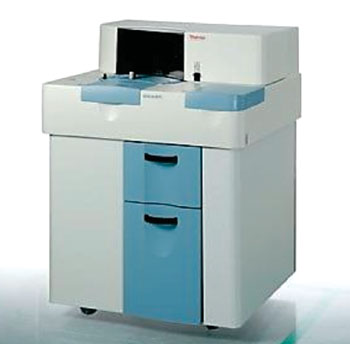Lipid Profiles Investigated for Coronary Heart Disease Patients
By LabMedica International staff writers
Posted on 23 Nov 2016
Lipoprotein (a) (Lp (a)) excess is an independent risk factor of coronary artery disease (CAD) and has shown wide ethnic variations and lipid parameters used in the assessment and management of risk factors for CAD may not reflect accurately the disease or its severity.Posted on 23 Nov 2016
Risk factors for Cardio Vascular Disease (CVD) comprise dyslipidemia, diabetes, hypertension, obesity, sedentary lifestyle, smoking, alcohol, family history, menopause and advancing age. Furthermore, homocysteine, fibrinogen, lipoprotein(a), low density lipoprotein particle size and C-reactive protein are the conditional risk factors that contribute to CVD.

Image: The Konelab 20XT clinical chemistry automated analyzer (Photo courtesy of Thermo Fisher Scientific).
Medical scientists at the University of Sri Jayewardenepura (Nugegoda, Sri Lanka) conducted a prospective cross sectional study during the years 2013 and 2014. The study sample consisted of 102 consenting patients awaiting Coronary Artery Bypass Graft (CABG) at the Cardiothoracic Unit of the local hospital. The majority of the patients (43.1 %) were between 51 and 60 years with 4.9 % less than 40 years. The mean age of male and female patients was 56.9 ± 10 and 57.8 ± 7.
Pre-operative blood samples were collected into plain tubes and the serum separated. Lp(a) content was measured by immunoturbidimetric method (Thermo Fisher Scientific, Helsinki, Finland) . The absorbance of the immune-complex, produced from Lp(a) and anti-serum was measured at 340 nm on a Thermo Scientific Konelab 20XT clinical chemistry automated analyzer. Data on total cholesterol, low density lipoprotein cholesterol (LDLc), high density lipoprotein cholesterol (HDLc), and triglyceride were collected from each patient’s data records and TC:HDLc ratio calculated.
The scientists reported that total cholesterol (TC), LDL cholesterol and HDL cholesterol of the total study sample (average ± SD) were, 150 ± 36 mg/dL, 92 ± 36 mg/dL and 34 ± 9 mg/dL respectively with no significant difference irrespective of being on pharmacological treatment or not. All lipid parameters were significantly high in females. The average Lp(a) was 50 ± 38 mg/dL with no significant difference in males or females independent of being on treatment (50 ± 39 mg/dL) or not (49 ± 39 mg/dL) and above the cut off value (30 mg/dL).
The authors concluded that despite pharmacological interventions 27 % of the study population had high LDLc and majority low HDLc. Mean Lp(a) was in excess irrespective of risk factors or being on treatment or not and is confirmed as an independent, potential marker for assessing the susceptibility for CAD especially in those with other intermediate risk factors but considered non-hyperlipidemic by conventional methods. The study was published on November 8, 2016, in the journal BMC Cardiovascular Disorders.
Related Links:
University of Sri Jayewardenepura
Thermo Fisher Scientific













